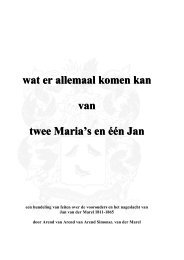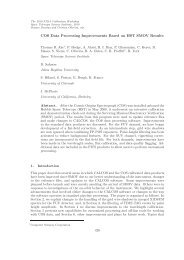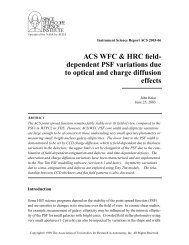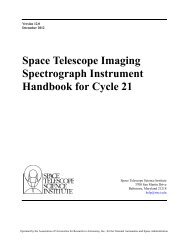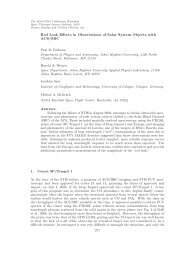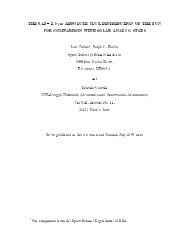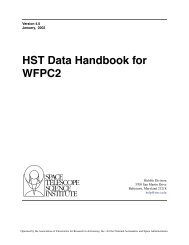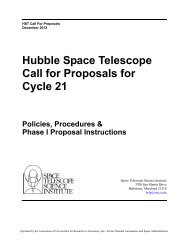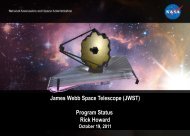STScI Annual Report 2002: A Living Mission
STScI Annual Report 2002: A Living Mission
STScI Annual Report 2002: A Living Mission
Create successful ePaper yourself
Turn your PDF publications into a flip-book with our unique Google optimized e-Paper software.
We at the Space Telescope Science Institute are pleased to bring you the<br />
good news of Hubble’s continued health and success. We are privileged to<br />
promote the science flowing from the community’s use of NASA’s most<br />
productive and most important scientific mission. We encourage you to<br />
recognize Hubble as a historic telescope and as a living mission, sustained<br />
on the cutting edge of science by new instrument development and shuttle<br />
servicing performed by modern explorers.<br />
We sometimes hear that Hubble is an old facility, but in many<br />
ways it is like that 19th century mansion: the Optical Telescope<br />
Assembly is still superb, the pointing control system is still the<br />
most accurate ever built, and the computer and power systems<br />
have been upgraded to modern standards. And—again, most<br />
importantly—Hubble’s scientific capabilities are state-ofthe-art<br />
and second-to-none because of new instruments.<br />
We have not reached the end of Hubble’s potential, although we<br />
may have reached the end of the public’s good will in supporting<br />
future upgrades. The Institute recently looked at ideas for new<br />
Hubble instruments and found two that would easily enhance<br />
performance by further factors of ten or more: an optical camera<br />
with a much wider field of view and a coronagraph for studying<br />
faint sources next to bright objects like planets around nearby<br />
stars. These ideas cannot exhaust the possibilities. Such new<br />
instruments would spur scientific advances at the end of this<br />
decade like those of ACS and the revived NICMOS today. They<br />
would create immediate opportunities for discovery and scientific<br />
inquiry that are not otherwise achievable in this decade, for they<br />
demand the superb Hubble optical telescope, support systems,<br />
and operational infrastructure, which are not likely to be recreated<br />
for many years after Hubble is turned off.<br />
In the recently released study of the scientific impact of NASA’s<br />
missions, Greg Davidson writes, “Large astronomical observatories<br />
continue to have very high scientific productivity—more than<br />
half of the science and technology return for NASA.” According<br />
to Davidson, “An analysis of 1990-1999 data by this metric<br />
(performed in January 2000) indicated that [the NASA Office of<br />
Space Science’s] large missions had twice the science productivity<br />
per dollar as smaller missions, and, if anything, the past three<br />
years have seen an even higher contribution from large observatories.<br />
With the installation of ACS in <strong>2002</strong> (along with restoration<br />
of NICMOS and continued operation of STIS), Hubble has<br />
essentially achieved the full level of instrumentation capability<br />
anticipated when the lifecycle servicing program was put<br />
into place just before launch in 1990, and should probably be<br />
performing at its peak.”<br />
<strong>STScI</strong> AR 02 | A <strong>Living</strong> <strong>Mission</strong><br />
perspective 3



